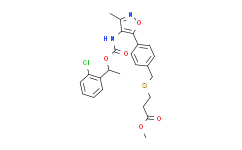| Cas No.: | 355025-13-7 |
| Chemical Name: | Methyl 3-({4-[4-({[1-(2-chlorophenyl)ethoxy]carbonyl}amino)-3-met Hyl-1,2-oxazol-5-yl]benzyl}sulfanyl)propanoate |
| Synonyms: | Methyl 3-({4-[4-({[1-(2-chlorophenyl)ethoxy]carbonyl}amino)-3-met hyl-1,2-oxazol-5-yl]benzyl}sulfanyl)propanoate;Ki16198 |
| SMILES: | COC(=O)CCSCC1=CC=C(C=C1)C2=C(NC(=O)OC(C)C3C(Cl)=CC=CC=3)C(C)=NO2 |
| Formula: | C24H25N2O5Scl |
| M.Wt: | 488.9837 |
| Purity: | >98% |
| Sotrage: | 2 years -20°C Powder, 2 weeks 4°C in DMSO, 6 months -80°C in DMSO |
| Description: | Ki16198 is a potent and orally active LPA receptor antagonist, the methyl ester of Ki16425 (HY-13285). Ki16198 inhibits LPA1 and LPA3-induced inositol phosphate production with Ki values of 0.34 μM and 0.93 μM, respectively. Ki16198 is effective for pancreatic cancer tumorigenesis and metastasis in vivo[1]. |
| In Vivo: | Ki16198 (oral administaion; 1 mg in 500 ul; 28 days) significantly decreases the degree of metastasis activity in Ki16198-treated mice. Similiar to liver, metastasis to lung and brain in mice is also observed[1]. Animal Model: Male BALB/c nude mice (6 weeks old)[1] Dosage: 1 mg in 500 ul Administration: Oral administaion; 28 days Result: Inhibited lung and liver metastasis in vivo. |
| In Vitro: | Ki16198 (0-10 μM; 48 hours) is effective to inhibit migration and invasion responses to LPA with a potency similar to that of Ki16425. The inhibitory effects Ki16198 on the invasion response to LPA, but not to EGF in several pancreatic cancer cell lines, including Panc-1,CFPAC-1, and BxPC-3 cells[1]. Ki16198 (10 μM; 48 hours) signifivcantly decreases expression of proMMP-9 protein and mRNA expression in YAPC-PD cells[1]. |
| References: | [1]. Mayumi Komachi, et al. Orally active lysophosphatidic acid receptor antagonist attenuates pancreatic cancer invasion and metastasis in vivo. Cancer Sci. 2012 Jun;103(6):1099-104. |

 DC Chemicals' products qualify for U.S. tariff exemptions. We guarantee no price increases due to customs duties and maintain stable supply, continuing to deliver reliable research solutions to our American clients.
DC Chemicals' products qualify for U.S. tariff exemptions. We guarantee no price increases due to customs duties and maintain stable supply, continuing to deliver reliable research solutions to our American clients.





















